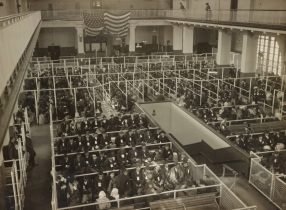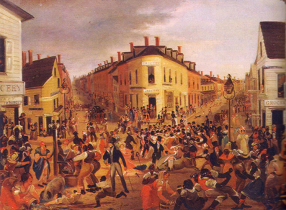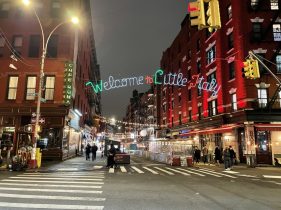Ellis Island
Although this time featured a flood of European immigrants from countless different nations conjugate on a small and otherwise unknown Ellis Island, the main port of entry for immigrants at this time, one population stood out among the rest in the busy streets of New York, and that was the Italian Americans.[1]

For nearly its first two centuries of existence New York City had little to no Italian presence among its population. The first Europeans to settle on the island of Manhattan were actually from Dutch decent, with the Netherlands laying claim to what they called New Amsterdam in 1624. This rule was short lived however when the English laid the eyes upon the strategic value of the location of the island of Manhattan. In 1664, just 40 years after the Dtuch settled there, the British took control of this island of Manhattan through a peaceful surrender and proudly named this new settlement New York. Through the British occupation of New York, the vast majority of its citizens were colonists mainly from the lands that made up the United Kingdom. The only other real ethnicity seen on the streets of New York during this period were African slaves. This is a trend that continued during the early years of the United States of America. As stated by Walks of New York, “in 1860 only about 1400 New Yorkers were of Italian descent”[2].
Five Points
Pretty much all of these Italian Americans during this time period were living in poverty, taking occupations such as laborers, dockworkers, or fruit vendors. Practically all of these early Italian New Yorkers lived in the slum-like area known as Five Points.[3] These early Italian Americans living in New York were also consistently grouped together with the much more prominent, yet not much more privileged, Irish Americans. Life was a daily uphill for Irish and Italians alike in 19th century New York City in which a lot of times their only impactful contribution to their society seemed to be voting for the already incredibly corrupt Tammany Hall politicians, who clearly could care less about the terrible living conditions these settlers were forced to deal with on a daily basis.

Despite this, the Italian population of New York in the 1800’s still found a way to at least make up some sort of respectful reputation by being looked at from the upper class as causing less issues, which is illustrated through a lens of upper-class bias by Jacob A. Riis in How The Other Half Lives, “In the slums he (the Italian) is welcomed as a tenant who ‘makes less trouble’ than the contentious Irishman or the order-loving German, that is to say: is content to live in a pig-sty and submits to robbery at the hands of the rent-collector without murmur” (Riis, 48)[4]. This view of the Italian American in New York would certainly be altered as a result of the flood of immigration that this country witnessed in the early 1900’s.
In the first 14 years of the 20th century, approximately two million Italians immigrated to America, with a large majority of them finding a permanent settlement in New York City. By the start of the 1930’s New York alone was home to over one million Italian Americans, making up just about 17 percent of the overall population of New York City. As a direct result of this, communities began to form in certain sections of the city.
Little Italy
The most notable Italian American neighborhood in New York City is a small area approximately 15 square block in Lower Manhattan surrounding Mulberry Street, widely known as Little Italy. This neighborhood is bordered to its west by Soho and Tribeca, to its south by Chinatown, to its east by the Bowery section, and to its north by Nolita. By the mid-1920’s, Little Italy was home to the most Italian American immigrants per square mile when compared to any other neighborhood in the country.


Although Little Italy was undoubtedly the most popular settling destination for Italian American during the turn of the century, other Italian communities began to sprout up all across the five boroughs. Other notable communities that a large number of Italian Americans called their home ware Bay Ridge, Belmont, and even some sections of Harlem.
The majority of these Italian immigrants settling in New York came from Southern Italy and Sicily. This was mainly due to socio-political changes in the country of Italy at this time that left many of these farmers and land workers without land. Due to the vast differences between Northern Italian and Southern Italian culture (with Northern Italians living a much more urban and industrial life whereas Southern Italian were more acclimated to the outdoors and labor-intensive work), many of these Southern Italian immigrants were not used to the way of life that New York City offered. Despite this, these Italian Americans found a large amount of success in climbing up the socio-economical ladder in New York City throughout the 20th century.
There were however, some down sides that were a result of the increased Italian American population in New York City. The most notable and synonymous negative aspect of Italian American life during this time period is organized crime. Like all of the other of Italy that fled to New York during this time, so do Mafias from all across Italy. Although many long term residents of New York commonly grouped the many different sects of Italian immigrants together, each individual Italian community in the city had a relationship with the regions of Italian in which the majority of their citizens came from. For example, Elizabeth Street was strictly Sicilians, funnily enough eventually losing a decent amount of its population to Peterstown in Elizabeth, NJ in the 1950’s, Mott Street was Calabresi, Baxter Street was Milanese, and Mulberry Street, although mainly consisted of Neopolitan, also included some Apulians.[5] These traditions and rivalries often resulted in violence on the streets of Little Italy and various other Italian neighborhoods of New York City during this time. Often times the only crimes committed by Italian immigrants during this time were committed against other Italian immigrants. Although this cultural separation is often times overlooked by those who may not understand these customs, one wild aspect to think of, especially in today’s society, is the fact that during this time a marriage between two people that were from different streets, even if they were neighboring streets, was considered to be a “mixed marriage”.[6]
All in all, the history of the Italian American immigration to New York City is one that is filled with many stories of hardships, adversity, sacrifices, and triumph. New York City has been instrumental in the growth and development of the modern Italian American we see across our country every day. Countless influential figures, actors, singers, politicians, and leaders that have shaped America’s culture have been of Italian descent and can, in one way or another, trace their families’ stories throughout New York City. In addition to this, New York City still displays a larger amount of Italian American culture and traditions to this day that not only highlight what is best about this wonderful city, but also add to its already culturally rich and socially abundant history that is continuing to be shaped to this day.
Works Cited
[1] Pencak, William, et al. Immigration to New York. Balch Institute Press, 1991
[2] “Italians of New York City.” Walks of New York, 1 Oct. 2013, https://www.walksofnewyork.com/blog/italians-new-york-city#:~:text=Between%201900%20and%201914%2C%20almost,landless%20farmers)%20fleeing%20severe%20poverty
[3] Ruberto, Laura E., et al. New Italian Migrations to the United States. Vol. 1, University of Illinois Press, 2017.
[4] Riis, Jacob A., and Hasia R. Diner. How the Other Half Lives: Authoritative Text, Contexts, Criticism. W.W. Norton & Co., 1890.
[5] Cinotto, Simone. The Italian American Table : Food, Family, and Community in New York City.
[6] Federal Writers’ Project (New York, N.Y.). The Italians of New York. Arno Press, 1969.
